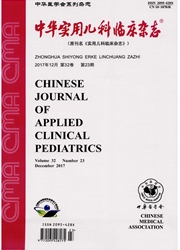

 中文摘要:
中文摘要:
目的 探讨细胞内低镁对皮质丘脑神经元网络兴奋性的影响.方法 通过计算机模型生物学模拟结合大鼠皮质丘脑脑片电生理记录实验,观测细胞内低镁对大电导的钾离子通道(BK通道)、N-甲基-D-天冬氨酸受体(NMDA受体)和皮质丘脑网络放电的影响.结果 1.在BK通道模型上,细胞内低镁并未显著削弱BK通道电流,未引发神经元兴奋性的改变.2.在NMDA受体模型上,细胞内低镁可引发NMDA电流的显著增强,从而导致兴奋性突触后膜电位(EPSPs)的显著增加.3.在大鼠的皮质丘脑脑片上,可以观察到细胞内低镁情况下皮质丘脑神经元网络的兴奋性突触后电位显著增加并产生(癎)样放电,在应用特异性的NMDA受体阻断剂后,兴奋性突触后电位减小,(癎)样放电消失.结论 细胞内镁离子浓度的降低将增强NMDA受体相关电流,从而引发皮质丘脑神经元网络的过度兴奋,最终导致(癎)样放电的产生.已证实一种高选择性镁离子转运体相关基因NIPA2与儿童失神癫(癎)密切相关,因此本研究发现的细胞内低镁导致(癎)样放电的机制可能提示儿童失神癫(癎)的发病机制.
 英文摘要:
英文摘要:
Objective To reveal the effects of low intracellular magnesium on the excitability of thalamocortical network.Methods Computational models and electrophysiological experiments were used to detect the effects of low intracellular magnesium on big-conductance potassium channels (BK channels),N-methyl-D-aspartate receptor (NMDAR) and thalamocortical network.Results 1.On BK channel model,low intracellular magnesium did not attenuate BK channel currents,and had no effect on neural excitability.2.On NMDAR model,low intracellular magnesium enhanced significantly excitatory postsynaptic potentials (EPSPs) by increasing NMDAR currents.3.In rat thalamocortical slice,increased EPSPs and epileptic discharges were observed,and they were attenuated by a specific NMDAR blocker.Conclusions Low intracellular magnesium may enhance the excitability of thalamocortical network and generate epileptic discharges through NMDAR pathway.Our previous study had demonstrated that a magnesium transporter gene NIPA2 was highly associated with childhood absence epilepsy.Therefore,low intracellular magnesium causing epileptiform activity may provide a clue to reveal the pathogenesis of childhood absence epilepsy.
 同期刊论文项目
同期刊论文项目
 同项目期刊论文
同项目期刊论文
 期刊信息
期刊信息
